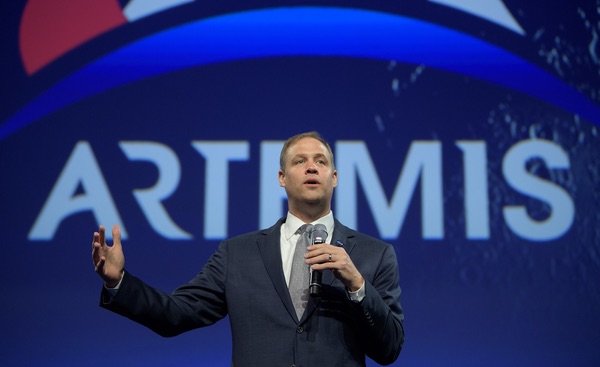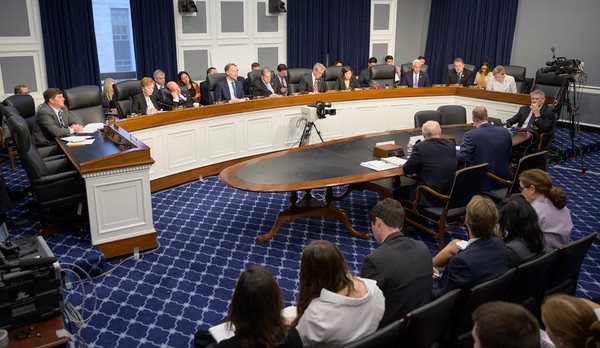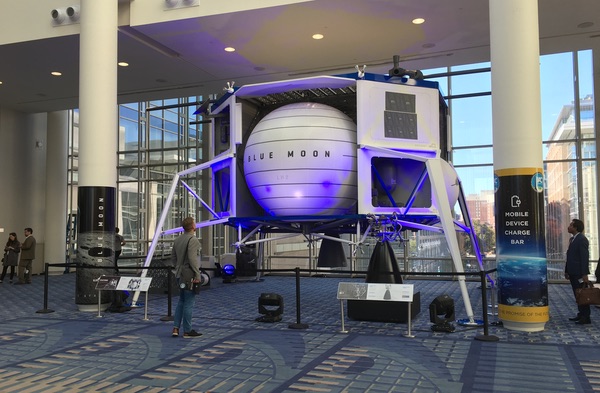Coming together to go to the Moonby Jeff Foust
|
| But is this upswing just the beginning of a long-term, sustainable effort that will finally return humans to the Moon after five decades, or is the cycle already reaching its peak? |
Inside the exhibit hall were a number of smaller models. The booth for the Israeli Space Agency had a model of the ill-fated Beresheet lander (at one point, late in the week-long conference, surrounded in police caution tape for some reason). Nearby, Firefly Aerospace had a model of its Genesis lunar lander it is developing in cooperation with Israel Aerospace Industries, which built Beresheet. Other booths included models of Astrobotic’s Peregrine lander and the lander being developed by Japan’s ispace.
It’s been clear for the last couple of years that lunar exploration was on its latest cyclic upswing. The administration first directed NASA to return humans to the Moon, then accelerated that timetable. International partners have expressed interest and even committed to participating in NASA’s plans, while companies offer their capabilities in the form of all those lunar landers, as well as other vehicles. But is this upswing just the beginning of a long-term, sustainable effort that will finally return humans to the Moon after five decades, or is the cycle already reaching its peak?
 NASA Administrator Jim Bridenstine makes the case for NASA’s Artemis program to return humans to the Moon during one of several events he participated in during the conference. (credit: NASA/Bill Ingalls) |
Public and private partnering
The IAC has long had an emphasis on international cooperation in civil spaceflight, and this year was no exception. This year, that focus on was lunar exploration, with NASA using the conference to emphasize its Artemis program to return humans to the Moon by 2024, in cooperation with international partners.
Two of NASA’s existing International Space Station partners have already committed to the program. Early this year, Canada announced it would invest about US$1.5 billion over more than two decades to develop a robotic arm for the lunar Gateway. (That cooperation appears likely to continue as the government of Prime Minister Justin Trudeau won federal elections while the conference was taking place, albeit now in a coalition with other parties.) Days before the conference, Japanese Prime Minister Shinzo Abe announced his country would cooperate with NASA on lunar exploration, including modules for the lunar Gateway.
The other two ISS partners, Europe and Russia, are expected to follow eventually. “We are planning to participate in the Gateway, but we don’t have a final decision how,” said Sergey Krikalev, executive director for piloted spaceflight at Roscosmos, at IAC, during a “heads of agencies” plenary session at the IAC.
The European Space Agency’s plans to cooperate on Artemis are pending decisions made by ministers of its 22 member states late next month at its “Space19+” meeting that will allocate funds for ESA programs for the next three years. ESA is seeking funding to start work on two modules for the Gateway and a large cargo lander that could be used for science payloads or delivering supplies to astronauts on the lunar surface.
In a later interview at the conference, Jan Wörner, director general of ESA, said his agency’s plans weren’t affected by the US government’s decision in March to move up the timetable for the first human landing by four years, to 2024. Most of ESA’s contributions, he noted, were planned for later in the decade anyway. “It’s just that the Americans decided to have two Americans on the surface of the moon in 2024,” he said. “That’s a national decision.”
| “This is a national team for a national priority,” Bezos said of Blue Origin’s partnership with three other companies. |
While the ISS partners—and, potentially, other nations—are increasingly committed to cooperating on Artemis, there’s still no formal structure yet for bringing everyone together. NASA administrator Jim Bridenstine said at a press conference during IAC that was premature to do so given that some agencies, like ESA, are still finalizing their financial commitments to the effort.
“It’s kind of like a jigsaw puzzle,” he said. “It takes some time to put it together, but all the pieces will come together. We just have to continue to work on it.”
When it does come together, Artemis is likely to use the same intergovernmental agreement, or IGA, as the ISS, or something very similar to it. Both Bridenstine and Wörner said that current agreement could likely be extended, through memoranda of understanding, to encompass the Gateway and lunar surface activities.
“Extending the IGA is the quickest way to make it happen,” Bridenstine said. “As long as well agree, we can keep moving forward.”
The biggest announcement from IAC, though, didn’t involve NASA or its partners. Speaking the conference last Tuesday, to accept a new “Excellence in Industry” award from the International Astronautical Federation, Blue Origin founder Jeff Bezos said his company was joining forces with three others to propose a human lunar lander to NASA.
Blue Origin will lead the team and develop a descent stage based on Blue Moon. Lockheed Martin will contribute an ascent stage that would host astronauts, leveraging technology from the Orion spacecraft. Northrop Grumman will provide a transfer stage based on its Cygnus spacecraft that would move the lander from the Gateway to low lunar orbit. Draper will contribute guidance, navigation and control systems for the lander.
“This is a national team for a national priority,” Bezos said.
The multi-company tie-up was surprising, in part because both Blue Origin and Lockheed Martin had previously talked about doing lunar landers on their own. Company officials said that NASA’s rush to get humans back to the Moon led them to join forces rather than go it alone.
“It’s not uncommon for all companies to lay out an architecture for an entire system,” said Brent Sherwood, vice president of advanced development programs at Blue Origin. Given both the work required and the 2024 deadline, “the most sensible thing was to get together to try to deliver this for NASA.”
The combination, the companies argued, leveraged their individual strengths. “It became very clear to us, as we broke apart the architecture into these pieces, that was in the best interest of our team,” said Frank DeMauro, sector vice president and general manager at Northrop Grumman.
While the announcement was timed to the IAC, it also took place during the ongoing NASA competition for Human Landing Services, the agency’s approach to fund the development of landers that will carry astronauts to and from the lunar surface. Much like the commercial crew program, NASA plans not to buy the landers themselves but instead support their development and then buy transportation services from the companies.
Proposals for that program are due to NASA November 5, and the agency expects to select several proposals for initial studies by January. NASA will then select one, or possibly two, companies to fund for full development; if NASA goes with two, one company would fly the first lunar landing mission in 2024 and the other the second a year later, with the two then competing for future contracts.
The Blue Origin-led team would appear to be a frontrunner for one of those initial awards. Other companies haven’t declared their intent to bid, but several are likely to submit proposals.
| “It’s hard to justify any extra spending on this effort in the current fiscal year when we don’t know the costs down the road,” said Serrano. |
One of those is Boeing. Last week Intuitive Machines announced it was working with Boeing on the development of engines for a lunar lander. While that work is technically for another program of lunar lander architecture studies (which predated the accelerated schedule for return humans to the Moon), the announcement suggested the two would partner for a lunar lander proposal.
“The relationship between Intuitive Machines and Boeing combines two stellar companies with ambition to fulfill NASA’s goal of returning to the Moon in 2024,” Trent Martin, vice president of aerospace services at Intuitive Machines, said in his company’s statement.
SpaceX may also bid on the competition, perhaps using its Starship vehicle, which would be far larger than any other lunar lander concept published to date. The company has suggested that Starship could land on the Moon as soon as 2022, albeit with cargo, rather than people.
Bridenstine said in a speech Friday at the last day of IAC that he expected SpaceX to propose Starship for the competition, but said he couldn’t be certain given the sensitive nature of the ongoing competition. “We want to go to the Moon with commercial landers, and Starship, of course, is a commercial lander that we anticipate will be competing in this program,” he said. “Do we know that? No, but, it certainly looks like they will be.”
 Bridenstine and Ken Bowersox, acting associate administrator for human exploration and operations, testify before a House appropriations subcommittee on the agency’s plans to land humans on the Moon by 2024. (credit: NASA/Bill Ingalls) |
Challenges ahead
If you based your assessment solely on those announcements and other comments at IAC, you’d come away with an optimistic view about NASA’s prospects for going back to the Moon with both international and commercial partners. But elsewhere in Washington, there are obstacles in the agency’s path.
Less than week before the IAC, Bridenstine testified before a House appropriations subcommittee about those lunar plans. That committee, in May, had not included the $1.6 billion in additional funding NASA sought in fiscal year 2020 to kickstart Artemis, in part because the committee was already finalizing its commerce, justice, and science (CJS) spending bill. Five months later, there was little sign that appropriators were more willing to support that request.
“It’s hard to justify any extra spending on this effort in the current fiscal year when we don’t know the costs down the road,” said José Serrano (D-NY), chairman of the CJS appropriations subcommittee, in his opening remarks at the hearing. NASA has yet to disclose what the overall cost of the Artemis program will be, beyond the $1.6 billion sought for 2020, and Bridenstine previously said that cost estimate may not be released until February, when the White House issues its fiscal year 2021 budget request.
Most expect NASA to need much more than $1.6 billion a year in 2021 through 2024—perhaps several billion a year in additional funding—which prompts concerns about the effects it will have elsewhere. Bridenstine reiterated at the hearing that NASA would not seek to “cannibalize” other parts of the agency, like science, to fund Artemis. Attempting to do so, he said, “will create a partisan divide that we do not want to have as an agency.”
Serrano, though, was worried about the effect an increase would have on other programs outside of NASA. “I don’t want to go to the Moon by taking money from people who can’t afford to survive in this society to the level that they should survive in this society,” he said, like Pell Grants for education or food stamps. The administration had, in its budget amendment, proposed offsetting the NASA increase by taking funds from a Pell Grant surplus fund, a proposal with few advocates in Congress.
It might be better, Serrano concluded, to stick to NASA’s earlier 2028 goal “in order to have a successful, safe and cost-effective mission for the benefit of the American people and the world.”
| “It would be devastating,” Bridenstine said of a CR at a Senate hearing in July. “If we end up in a CR, that lander doesn’t continue to get developed.” |
Other Democratic members also argued that they needed to know the full estimated cost of Artemis before being willing to support any funding in 2020. “I want to help NASA meet its goal of 2024, but I need to see a schedule and cost estimate to understand how best to do that,” said Rep. Charlie Crist (D-FL). Republicans at the hearing, though, were more concerned about whether NASA was adequately supporting programs like the Space Launch System, and if the agency was relying too much on commercial launch vehicles to carry out its exploration plans.
Senate appropriators, by comparison, gave NASA most of what it wanted in its appropriations bill, although it funded the human lunar lander program at less than $750 million, versus NASA’s request for $1 billion. The Senate Appropriations Committee approves its CJS spending bill last month, and the full Senate may vote on it this week, setting up a conference with the House to reconcile differences between their two versions.
Bigger issues, though, could slow that work. Last week, Sen. Richard Shelby (R-AL), chairman of the Senate Appropriations Committee, said he expected that the work on fiscal year 2020 appropriations bills won’t be completed before the current continuing resolution (CR), or stopgap funding bill, expires November 21. (That CR is funding the federal government at fiscal year 2019 levels since the start of the 2020 fiscal year October 1.) He said another CR will be required, and might need to run until February or March.
That second, longer CR could pose a problem for NASA because new programs can’t be started under a CR unless a specific exception, or “anomaly,” is included in that bill. The CR currently funding the government is a so-called “clean” one without anomalies, and it’s not certain if the new CR will similarly lack such exceptions.
Bridenstine previously warned that a long-term CR would have major consequences for the Artemis program. “It would be devastating,” Bridenstine said of a CR at a Senate hearing in July. “If we end up in a CR, that lander doesn’t continue to get developed.”
One of the reasons another CR could last for months is the belief that other work on Capitol Hill will grind to a halt if the House conducts impeachment proceedings of President Trump that, is passed, would then go to the Senate for a trial. In such an environment there would be little time to handle other work, including appropriations bills.
Impeachment may also widen the partisan divides in Congress, making it harder for bipartisan cooperation needed for efforts like funding NASA’s lunar ambitions. Asked during IAC whether impeachment would jeopardize that, Bridenstine answered, “I honestly don’t know.”
He added, though, that he still believed that support for NASA crossed the aisle. “What we are trying to achieve here is not partisan in any way, shape, or form. We have strong bipartisan support.”
Serrano, at the earlier hearing, also said he wasn’t opposed to the program, but instead wanted to know how much it would cost before he made a decision on funding it. Informed that his opening comments led to comments in social media that he had effectively “killed” Artemis, he said in his closing remarks that was not the case.
“I don’t have that kind of power. I didn’t kill the mission,” he said to Bridenstine. “I just asked some questions that I know you know need to be answered before we move forward, or not.” When, and how, Bridenstine answers those questions could make all the difference in how many of those lunar lander mockups on display at the convention center last week ever become actual spacecraft.
Note: we are temporarily moderating all comments subcommitted to deal with a surge in spam.
